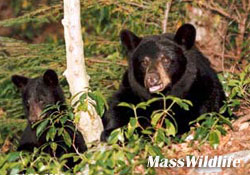By: Tim Phelon
Colonial Decline
Before European colonists arrived at Plymouth Rock, the area that would become Massachusetts was filled with unbroken hardwood forests and the multitude of mammals that inhabited them. The colonists soon started clearing large tracts of forest for timber and farmland. Many mammals were hunted and killed indiscriminately for fresh meat, furs, or to protect the settlers’ livestock. Within one hundred years many of the native mammal populations had been drastically reduced or even eliminated from many parts of the Northeast. This included moose, elk, cougars, black bears, wolves, beavers, martens, and wolverines. Moose, elk, black bears, martens, and beavers were hunted for food or for their furs, while wolves, cougars, and wolverines were considered to be a nuisance or a threat and were killed on sight.

A large bull moose in Massachusetts.
Resurgence
Recently a few of these species have started to make a comeback. This gives biologists hope that other species will eventually return as well. The moose is one of the best examples of this recent comeback. Moose have been gradually moving south into their former range for years now. Local populations are steadily growing in many parts of Massachusetts and the surrounding states. Beavers have a similar story, at first a few returned on their own and then some were released in the 1930’s and now the population is strong statewide. Black bears were never completely exterminated from Massachusetts and they have bounced back very well. In the 1970’s the bear population was still fairly low, but now the population is up to about 3000 individuals. Wolves were essentially replaced by the coyotes that moved into the area in the 1950’s. Sightings of both wolves and cougars in Massachusetts still happen, although very few are ever confirmed. A wolf was killed in Franklin County in 2007 and cougar scat, but no cougar, was found near the Quabbin Reservoir in 1997. It is unknown if these were wild or escaped captive animals. Wolverines, martens, and elk were fairly rare before colonists arrived and they are the least likely to make a return to Massachusetts.


The 2 largest predators currently living in Massachusetts; the Eastern Coyote and the Black Bear.
Conservation Efforts
The biggest reason for this resurgence of mammals is habitat conservation. When colonists arrived and started farming the land, a very high percentage of the forests were removed. Thanks to the relocation of farming to the Midwest, many of the areas that were once agricultural fields were abandoned and the forest’s trees and plants were able to grow. Today, 62% of Massachusetts’ 10,555 square miles are forested. The second reason for this recovery is the institution of new hunting and trapping laws. It is no longer legal to take an unlimited number of any species at any time. Moose are illegal to hunt in Massachusetts and the other mammal species have well regulated hunting and trapping seasons. Large predators like the bear and coyote have benefited from the increase in the number of prey species, like the beaver, deer, and to a lesser extent the moose. The increase in forested land and biodiversity opens the door for the eventual return of other native predator and prey species.

The remnants of a farm’s stone wall in a now forested Massachusetts State Park.
References-
Leave a comment